So引导的倒装句型
- 格式:doc
- 大小:26.00 KB
- 文档页数:1

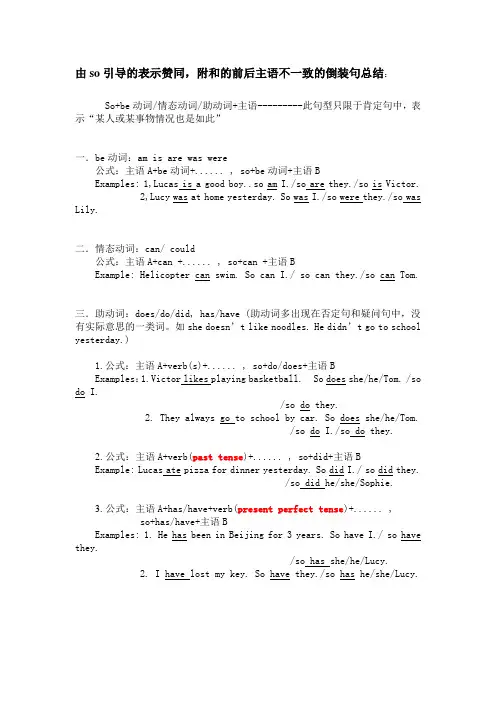
由so引导的表示赞同,附和的前后主语不一致的倒装句总结:So+be动词/情态动词/助动词+主语---------此句型只限于肯定句中,表示“某人或某事物情况也是如此”一.be动词:am is are was were公式:主语A+be动词+...... , so+be动词+主语BExamples: 1,Lucas is a good boy..so am I./so are they./so is Victor.2,Lucy was at home yesterday. So was I./so were they./so was Lily.二.情态动词:can/ could公式:主语A+can +...... , so+can +主语BExample: Helicopter can swim. So can I./ so can they./so can Tom.三.助动词:does/do/did, has/have (助动词多出现在否定句和疑问句中,没有实际意思的一类词。
如she doesn’t like noodles. He didn’t go to school yesterday.)1.公式:主语A+verb(s)+...... , so+do/does+主语BExamples:1.Victor likes playing basketball. So does she/he/Tom. /so do I./so do they.2. They always go to school by car. So does she/he/Tom./so do I./so do they.2.公式:主语A+verb(past tense)+...... , so+did+主语BExample: Lucas ate pizza for dinner yesterday. So did I./ so did they./so did he/she/Sophie.3.公式:主语A+has/have+verb(present perfect tense)+...... ,so+has/have+主语BExamples: 1. He has been in Beijing for 3 years. So have I./ so have they./so has she/he/Lucy.2. I have lost my key. So have they./so has he/she/Lucy.对应练习题:1.People in England eat a lot of potatoes. So _____we.2.He often gets up at 7 o’clock. So _______ I.3.The boy likes grapes. So _______Lucy.4.They come from America. So ______Sean.5.Tom is a good at swimming. So ________Lily.6.Peter is 8 years old. So ______we.7.They were at Lucy’s birthday party last night. So ______he.8.Xiaoming bought a bike. So ______I.9.Lily works hard. So _______ Sophie.10.Tom has a computer. So ______they.11.Victor has been to Shanghai. So _____Lucas.12.We have studied 1000 English words by the end of term. So _____he.13.I have a very interesting book. So ______she.14.Tom can run very fast. So _______ Lucy.15.They worked all day yesterday. So ________I.16.They have been to the Great Wall. So _______I.17.He had a new phone yesterday. So ________Lucy.18.Sean is our teacher. So ________Dana.19.Patrick has long legs. So _______Ben.20. Lucy’s mom is thin. So ________Lucas’ mom.(注:专业文档是经验性极强的领域,无法思考和涵盖全面,素材和资料部分来自网络,供参考。
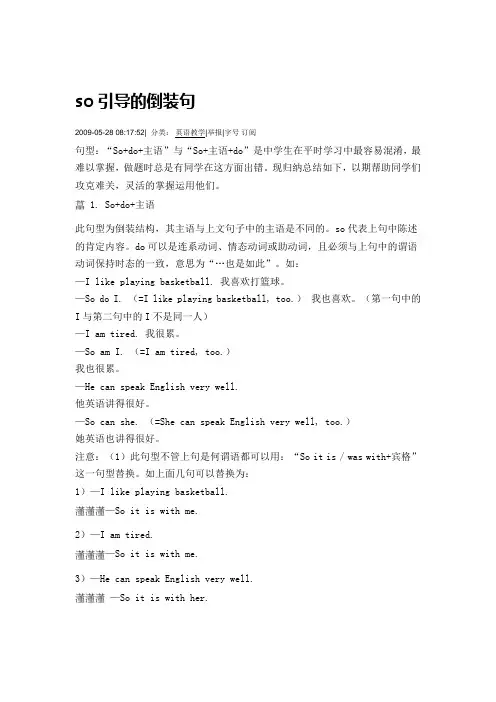
so引导的倒装句2009-05-28 08:17:52| 分类:英语教学|举报|字号订阅句型:“So+do+主语”与“So+主语+do”是中学生在平时学习中最容易混淆,最难以掌握,做题时总是有同学在这方面出错。
现归纳总结如下,以期帮助同学们攻克难关,灵活的掌握运用他们。
1. So+do+主语此句型为倒装结构,其主语与上文句子中的主语是不同的。
so代表上句中陈述的肯定内容。
do可以是连系动词、情态动词或助动词,且必须与上句中的谓语动词保持时态的一致,意思为“…也是如此”。
如:—I like playing basketball. 我喜欢打篮球。
—So do I. (=I like playing basketball, too.)我也喜欢。
(第一句中的I与第二句中的I不是同一人)—I am tired. 我很累。
—So am I. (=I am tired, too.)我也很累。
—He can speak English very well.他英语讲得很好。
—So can she. (=She can speak English very well, too.)她英语也讲得很好。
注意:(1)此句型不管上句是何谓语都可以用:“So it is / was with+宾格”这一句型替换。
如上面几句可以替换为:1)—I like playing basketball.—So it is with me.2)—I am tired.—So it is with me.3)—He can speak English very well.—So it is with her.(2)此句型只用于肯定句。
否定句要用“neither/nor+do+主语”或“So it is with+宾格”结构。
如:—He cant’t speak Russian.他不会讲俄语。
—Neither / nor can I. 或者—So it is with me. (=I can’t speak Russian, either.)我也不会讲俄语。
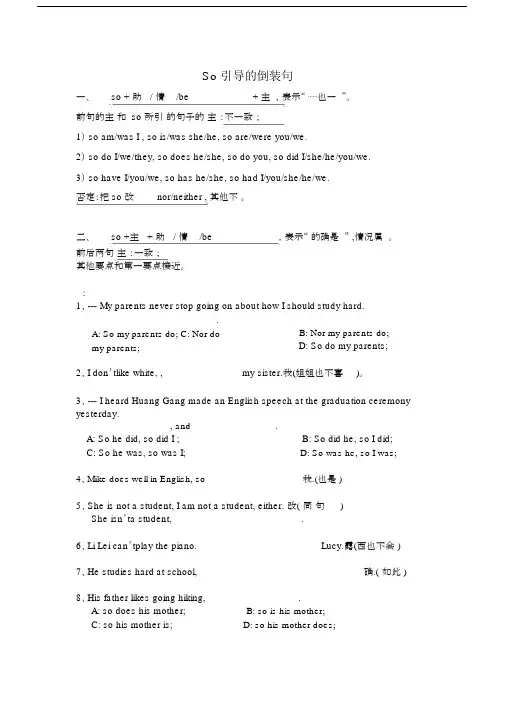
So 引导的倒装句一、so + 助 / 情 /be+ 主,表示“⋯⋯也一”。
前句的主和 so 所引的句子的主:不一致;1) so am/was I , so is/was she/he, so are/were you/we.2) so do I/we/they, so does he/she, so do you, so did I/she/he/you/we.3) so have I/you/we, so has he/she, so had I/you/she/he/we.否定:把 so 改nor/neither , 其他不。
二、so +主 + 助 / 情 /be,表示“ 的确是” ,情况属。
前后两句主:一致;其他要点和第一要点接近。
:1、--- My parents never stop going on about how I should study hard.--- ______________________.A: So my parents do; C: Nor do my parents;B: Nor my parents do; D: So do my parents;2、I don’tlike white, , ______________ my sister.我(姐姐也不喜)。
3、--- I heard Huang Gang made an English speech at the graduation ceremony yesterday.--- ______________, and ________________.A: So he did, so did I ; C: So he was, so was I;B: So did he, so I did; D: So was he, so I was;4、Mike does well in English, so _________ _________我.(也是 )5、She is not a student, I am not a student, either. 改(同句)She isn’ta student, ________________________.6、Li Lei can’tplay the piano. ___________ ___________ Lucy.露(西也不会 )7、He studies hard at school, _________ _________ ____________确.(如此 )8、His father likes going hiking, _________________.A: so does his mother;B: so is his mother;C: so his mother is;D: so his mother does;9、He hasn’tbeen to England before, ___________ ____________ I.我(也没去过 )10、---They haven’tbeen there before.--- ______________.A: Neither have I; C: Nor have I;B: So have I; D: Neither have I;11、Michael did not do his homework yesterday, ___________ _____________ his sister. (他妹妹也没做 )12、---Where is Tom--- Oh, Mary’s gone swimming and ____________.A: so is Tom;B: so Tom has;C: so has Tom;D: so Tom is;13、--- He is good at swimming.--- So __________. He swims best in our class.A: he is;B: is he;C: he does;D: does he;14、---I really hate winter, becauseI m’ afraid of coldness.--- ________________.A: So did I;B: So do I;C: So I do;D: So I did;。
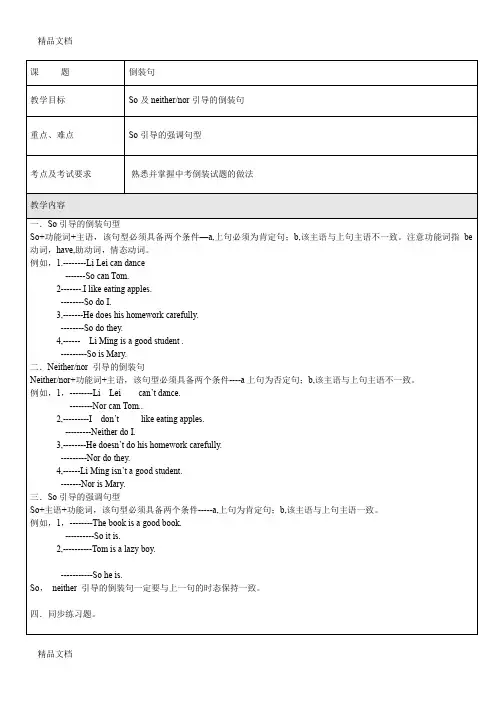
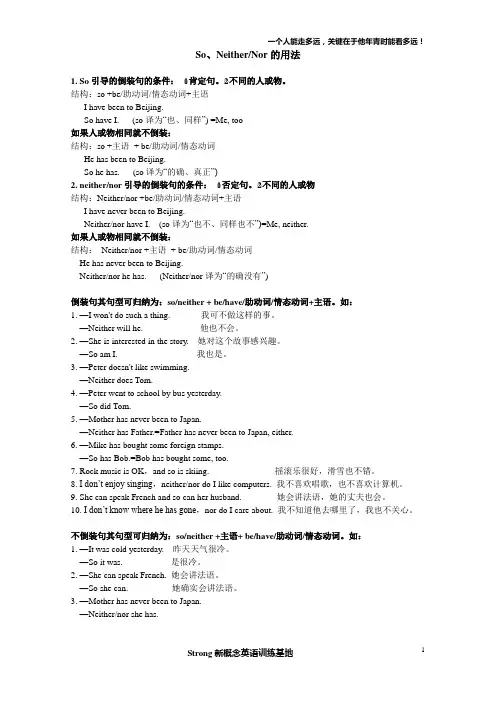
So、Neither/Nor的用法1. So引导的倒装句的条件:○1肯定句。
○2不同的人或物。
结构:so +be/助动词/情态动词+主语I have been to Beijing.So have I. (so译为“也、同样”) =Me, too如果人或物相同就不倒装:结构:so +主语+ be/助动词/情态动词He has been to Beijing.So he has. (so译为“的确、真正”)2. neither/nor引导的倒装句的条件:○1否定句。
○2不同的人或物结构:Neither/nor +be/助动词/情态动词+主语I have never been to Beijing.Neither/nor have I. (so译为“也不、同样也不”)=Me, neither.如果人或物相同就不倒装:结构:Neither/nor +主语+ be/助动词/情态动词He has never been to Beijing.Neither/nor he has. (Neither/nor译为“的确没有”)倒装句其句型可归纳为:so/neither + be/have/助动词/情态动词+主语。
如:1. —I won't do such a thing. 我可不做这样的事。
—Neither will he. 他也不会。
2. —She is interested in the story. 她对这个故事感兴趣。
—So am I. 我也是。
3. —Peter doesn't like swimming.—Neither does Tom.4. —Peter went to school by bus yesterday.—So did Tom.5. —Mother has never been to Japan.—Neither has Father.=Father has never been to Japan, either.6. —Mike has bought some foreign stamps.—So has Bob.=Bob has bought some, too.7. Rock music is OK,and so is skiing. 摇滚乐很好,滑雪也不错。
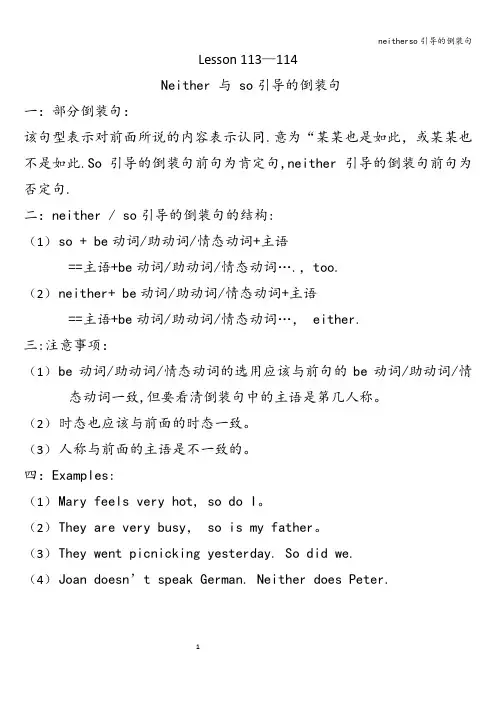
neitherso引导的倒装句
Lesson 113—114
Neither 与 so引导的倒装句
一:部分倒装句:
该句型表示对前面所说的内容表示认同.意为“某某也是如此,或某某也不是如此.So引导的倒装句前句为肯定句,neither引导的倒装句前句为否定句.
二:neither / so引导的倒装句的结构:
(1)so + be动词/助动词/情态动词+主语
==主语+be动词/助动词/情态动词….,too.
(2)neither+ be动词/助动词/情态动词+主语
==主语+be动词/助动词/情态动词…, either.
三:注意事项:
(1)be动词/助动词/情态动词的选用应该与前句的be动词/助动词/情态动词一致,但要看清倒装句中的主语是第几人称。
(2)时态也应该与前面的时态一致。
(3)人称与前面的主语是不一致的。
四:Examples:
(1)Mary feels very hot, so do I。
(2)They are very busy, so is my father。
(3)They went picnicking yesterday. So did we.
(4)Joan doesn’t speak German. Neither does Peter.
1。

sosuch倒装句用法
倒装句是指将完整的句子中的主语和动词的位置颠倒过来的语法结构。
Sosuch倒装句是一个常见的类型,用于表达"如此"或者"这么"的程度副词"so"或"such"。
具体用法如下:
1. "So + adj/adv + 主语 + 动词"的倒装形式,用于强调主语或情
感色彩。
例句:
- So beautiful is the view that it takes my breath away.(如
此美丽的景色让我惊叹。
)
- So loudly did he shout that everyone could hear him. (他
喊得这么大声,每个人都能听到。
)
2. "Such + 名词 + that + 主语 + 动词"的倒装形式,用于强调特
定事物或情况。
例句:
- Such is the impact of technology that it has transformed our lives.(科技的影响力如此之大,已经改变了我们的生活。
)- Such were the conditions that they had no choice but to leave.(条件就是这样,他们别无选择,只能离开。
)
需要注意的是,倒装句通常在强调或修辞的需要下使用,不是所有情
况都适用于倒装句。
另外,倒装句使用时也需要注意语序的正确性。
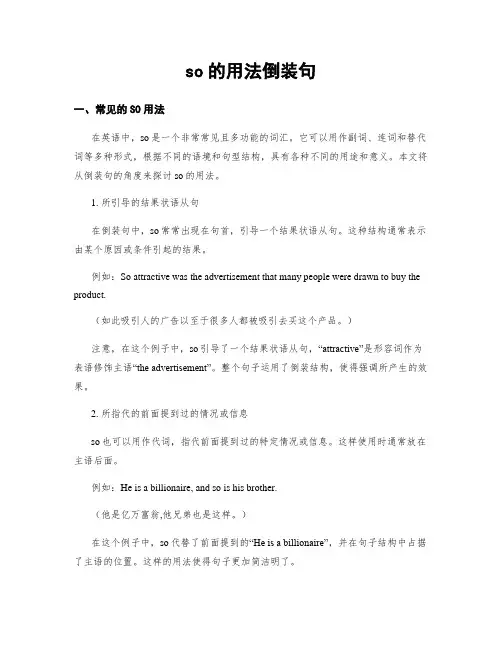
so的用法倒装句一、常见的SO用法在英语中,so是一个非常常见且多功能的词汇。
它可以用作副词、连词和替代词等多种形式,根据不同的语境和句型结构,具有各种不同的用途和意义。
本文将从倒装句的角度来探讨so的用法。
1. 所引导的结果状语从句在倒装句中,so常常出现在句首,引导一个结果状语从句。
这种结构通常表示由某个原因或条件引起的结果。
例如:So attractive was the advertisement that many people were drawn to buy the product.(如此吸引人的广告以至于很多人都被吸引去买这个产品。
)注意,在这个例子中,so引导了一个结果状语从句,“attractive”是形容词作为表语修饰主语“the advertisement”。
整个句子运用了倒装结构,使得强调所产生的效果。
2. 所指代的前面提到过的情况或信息so也可以用作代词,指代前面提到过的特定情况或信息。
这样使用时通常放在主语后面。
例如:He is a billionaire, and so is his brother.(他是亿万富翁,他兄弟也是这样。
)在这个例子中,so代替了前面提到的“He is a billionaire”,并在句子结构中占据了主语的位置。
这样的用法使得句子更加简洁明了。
二、倒装句中so的其他用法除了上述常见用法外,在倒装句中so还可以表示其他含义和功能。
下面将介绍两种典型的情况。
1. 表示同等程度或类似关系当so处于倒装句中,并且其后紧跟着形容词或副词时,它可以表示与前面所讲情况相同或者类似的程度。
例如:He is clever, and so are his siblings.(他很聪明,他兄弟姐妹也是如此。
)在这个例子中,so表达了主语和谓语之间类似程度的关系,强调了他和他的兄弟姐妹都具有聪明才智。
2. 表示目标、对立或补充关系当so位于倒装句中,并且接着出现一个特定动作、状态或观点时,它可以表达目标、对立或补充等不同类型的语义关系。
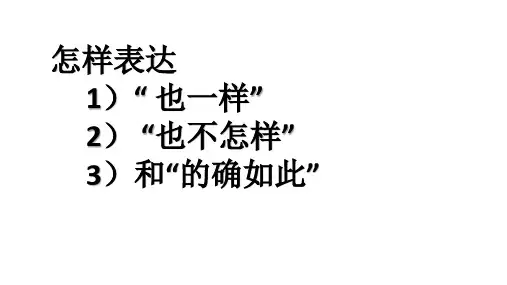
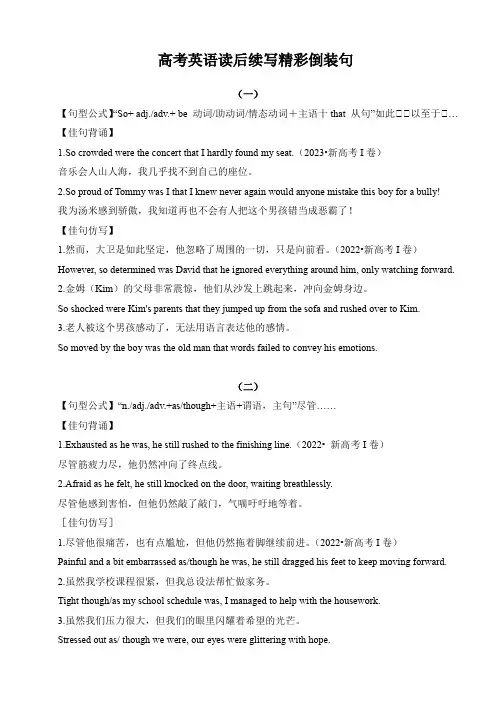
高考英语读后续写精彩倒装句(一)【句型公式】“So+ adj./adv.+ be 动词/助动词/情态动词+主语十that 从句”如此⋯⋯以至于⋯…【佳句背诵】1.So crowded were the concert that I hardly found my seat.(2023•新高考I卷)音乐会人山人海,我几乎找不到自己的座位。
2.So proud of Tommy was I that I knew never again would anyone mistake this boy for a bully!我为汤米感到骄傲,我知道再也不会有人把这个男孩错当成恶霸了!【佳句仿写】1.然而,大卫是如此坚定,他忽略了周围的一切,只是向前看。
(2022•新高考I卷)However, so determined was David that he ignored everything around him, only watching forward.2.金姆(Kim)的父母非常震惊,他们从沙发上跳起来,冲向金姆身边。
So shocked were Kim's parents that they jumped up from the sofa and rushed over to Kim.3.老人被这个男孩感动了,无法用语言表达他的感情。
So moved by the boy was the old man that words failed to convey his emotions.(二)【句型公式】“n./adj./adv.+as/though+主语+谓语,主句”尽管……【佳句背诵】1.Exhausted as he was, he still rushed to the finishing line.(2022• 新高考I卷)尽管筋疲力尽,他仍然冲向了终点线。
2.Afraid as he felt, he still knocked on the door, waiting breathlessly.尽管他感到害怕,但他仍然敲了敲门,气喘吁吁地等着。
结果状语从句对应的so/such位于句首引起的倒装句当“so/such ... that ...”结构中的so, such连同它所直接修饰的成分共同位于句首表示强调时,主句要进行倒装(that后面的结果状语从句不倒装)。
例如:So angry was he that he couldn’t speak. 他愤怒得一句话也说不出来。
So fast does he run that he is far ahead of others. 他跑得如此快,以至于远远领先于其他人。
To such an extent do the parents love their son that they have tried to satisfy every demand of his. 父母俩爱子爱到了如此程度,以至于尽量满足他的任何要求。
[考题1]So difficult ____ it to work out the problem that I decided to ask Tom for advice. (2006广东)A.I did findB. did I findC. I have foundD. have I found[答案]B[解析]so difficult放于句首要引起主句的倒装,结果状语从句中的“I decided to ask Tom for advice”表明整句话是针对过去的(不强调与现在的关联),不宜用现在完成时而应采用一般过去时,因此本题应选B。
[考题2]____ homework did we have to do that we had no time to take a rest. (2006福建)A.So muchB. Too muchC. Too littleD. So little[答案]A[解析]结果状语从句中的“we had no time to take a rest”意味着休息时间很少,应先排除选项C、D,又由于放于句首的表语too much 不能引起倒装,而且意思上也难以与全句融合,所以进一步排除B。
2018中考英语复习知识点:so,neither
引导的倒装句
2018中考英语复习知识点:引导的倒装句引导的倒装句引导的倒装句,为了避免和前一句话的内容重复,英语中习惯用引导的倒装句。
a.So+be(助动词,情态动词)+主语。
表示某人也是如此。
eg.Mike has bouggn sta
So has Bob.=Bob has boug
b.Neither+be(助动词,情态动词)+主语,表示某人也不。
egas never bapan.
Nas Father.=Father has never bapa
c.So+主语+be(助动词,情态动词)。
表示果真如此(赞同),请同学们与a.区别。
eg.A:gla
B:He is reallla
3.It’s+时间+since动词过去式。
自从...起已有...时间了。
⑴It’s two wwe met last.(自从我们上次见面已有两个星期了)
⑵How longwe left Beijing?(自从我们离开北京已有多久了。
如何使用so和neither引导的倒装句而在第二册第92课的课文中,原文用法如下:- I enjoy cleaning windows at night.-So do I.从以上的课文用法中,我们可以总结出so和neither引导的倒装句的用法:1、so用于肯定句,neither用于否定句。
2、so和neither在句子中的用法是相同的,其结构为:so/neither + 情态动词或助动词或系动词be + 主语+ 句号需要注意的是,so和neither引导的倒装句,既可以位于句首开头,也可以由并列连词连接,作为并列句紧跟前句。
如:He reads a lot and so does she.He doesnt read a lot and neither does she.在实际使用过程中,需要注意以下几点:1、到底使用so还是neither取决于前句话是肯定句还是否定句;2、无论前句话是肯定句还是否定句,so和neither引导的倒装句都是肯定句,由neither引导的倒装句不能再加not;3、倒装句中的情态动词或助动词或系动词be如何选择,取决于前句话中是否还有这三类辅助动词,而这些辅助动词中的助动词或系动词be的单复数取决于倒装句句末主语的单复数。
接下来我们看一些例句:1、do/does/didI like classical music.So does he.He often gets up early.So do I.He didnt have any bread.Neither did she.2、have/has/hadThey have been to France twice.So has she.He has left Shanghai.So have they.We hadnt come back before you arrived.Neither had they.3、willHe will reach the town tomorrow.So will she.If she go there,so will I.They wont give you any help.Neither will we.If she doesnt go there,neither will I.4、can或mustShe can drive a car.So can he.I cant stay here for the ngiht.Neither can she.We must finish the job on time.So must they.She neednt go there on Sunday.Neither must he.(注意neednt是must的否定形式)5、beHe is a doctor.So am I.They are from Canada.So are we.She isnt our English teacher.Neither is he.We are not going to attend the meeting.Neither is she.以上并未穷尽所有助动词或情态动词或系动词be的用法,但只要掌握基本的方法,就能正确使用了。
so, neither引导的倒装句一.“so,neither”开头的倒装句的基本含义上句话提到的情况同样适合下文的人或物, 为了避免和上文的内容重复,英语习惯用so, neither/nor引导的倒装句。
so引导的倒装句表示肯定,neither/nor引导的倒装句表示否定,其时态与前一句时态保持一致,上下文陈述的不是同一人或事物。
1.—Belle has just bought some foreign stamps. Belle刚买了一些外国邮票。
—So has Winnie. =Winnie has bought some foreign stamps, too. Winnie也买了一些外国邮票。
2.—What bad weather! The wind is blowing strongly with lots of sand. I don‟t like such wea ther. 多么坏的天气!风挟带沙子猛烈地吹。
我不喜欢这样的天气。
—Neither does Mary.= Mary doesn't like such weather, either. Mary也不喜欢这样的天气。
3.—Victor…s been travelling around the world. He has been to Austria. Victor一直在环球旅行,他已去过奥地利。
—So have I (=Me, too=I have been to Austria, too). I'm considering going there a secondtime. 我也去过奥地利。
我正考虑再一次去那儿。
4.—Sam can't see the paintings clearly from here. Sam从这儿看不清那些画。
—Neither can I.=Me, neither.=I can't see the paintings clearly from here, either. 我从这儿也看不清那些画。
英语倒装句的四种基本句型例句嗨,小伙伴们!今天咱们来好好唠唠英语倒装句的四种基本句型,这可真是英语学习里超有趣的一部分呢。
就像一场奇妙的语言魔术,让句子变得超级有特色。
**一、完全倒装(Full Inversion)**完全倒装就是把整个谓语动词都放到主语之前啦。
这就好比是把一场演出的主角(主语)和配角(谓语)的出场顺序完全颠倒了一下,给人一种很新奇的感觉。
例句1:There goes the bell.(铃响了。
)你看,正常的语序应该是The bell goes there. 但是这样一倒装,就有一种突然性,就像你正等着什么事情发生,然后“铃就响了”,这种表达更加生动。
我还记得我刚学这个的时候,我同学问我:“为啥要这么说呀?直接说The bell goes there不就得了?”我就跟他说:“哎呀,这就像你去看魔术表演,魔术师要是按平常的方式出牌,那还有啥惊喜呢?这种倒装句就像魔术里的大变活人,突然把主语和谓语的位置变了,让句子变得超酷。
”例句2:Here comes the bus.(公共汽车来了。
)想象一下,你在车站等车等得心急火燎的,然后你大喊一声“Here comes the bus”,是不是感觉比“The bus comes here”更带感呢?这时候句子就像是一个充满活力的小助手,快速地把重要的信息“bus来了”传达给你。
例句3:Away flew the birds.(鸟儿飞走了。
)这个句子要是正常说就是The birds flew away. 可一旦倒装,就像是我们在描述一个很突然的画面,鸟儿“嗖”的一下就飞走了,那种动态感更强了。
我跟我的英语老师讨论这个句子的时候,老师说:“你看,这种倒装就像是给句子加了个加速器,让动作更迅速地呈现在读者或者听者的脑海里。
”我当时就觉得,哇塞,真的是这样呢!**二、部分倒装(Partial Inversion)**部分倒装呢,就是只把助动词、情态动词或者be动词放到主语前面,主要动词还在主语后面呢。
一.So引导的倒装句型
So+功能词+主语,该句型必须具备两个条件—a,上句必须为肯定句;b,该主语与上句主语不一致。
注意功能词指be动词,助动词,情态动词。
例如,1.--------Li Lei can dance ------So can Tom.
2-------.I like eating apples. --------So do I.
3,-------He does his homework carefully. --------So do they.
4,------ Li Ming is a good student . ---------So is Mary. 二.Neither/nor 引导的倒装句
Neither/nor+功能词+主语,该句型必须具备两个条件----a上句为否定句;b,该主语与上句主语不一致。
例如,1,--------Li Lei can’t dance.--------Nor can Tom..
2,---------I don’t like eating apples. ---------Neither do I.
3,--------He doesn’t do his homework carefully.---------Nor do they.
4,------Li Ming isn’t a good student.-------Nor is Mary.
三.So引导的强调句型
So+主语+功能词,该句型必须具备两个条件-----a,上句为肯定句;b,该主语与上句主语一致。
例如,1,--------The book is a good book. ----------So it is.
2,----------Tom is a lazy boy. -----------So he is.
四.too 和either
too 用于肯定形式的动词后either 用于否定形式的动词后
I enjoyed the film yesterday. I enjoyed it too
I can’t cook. I can’t, either.。